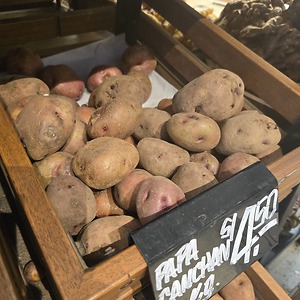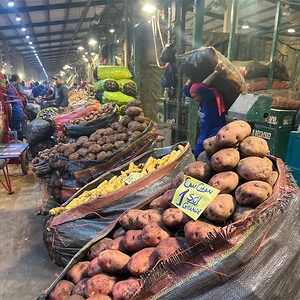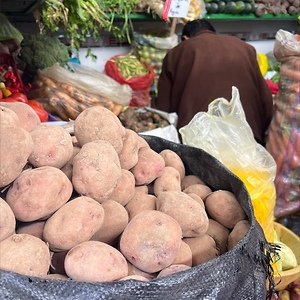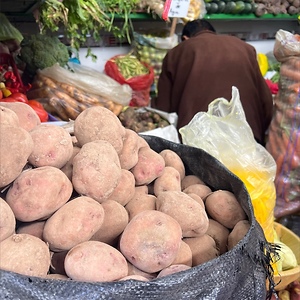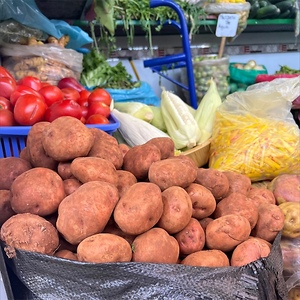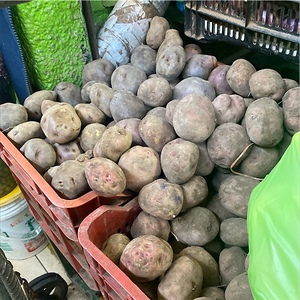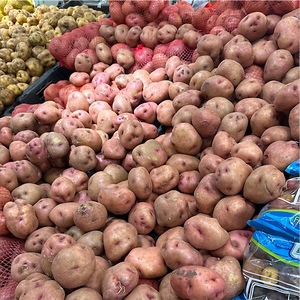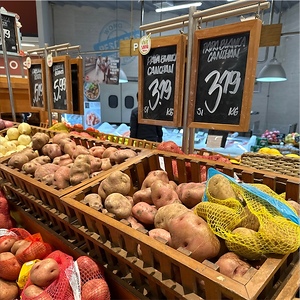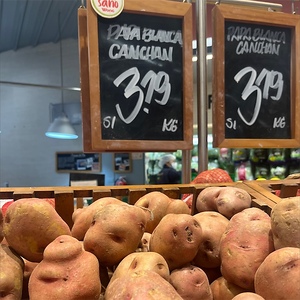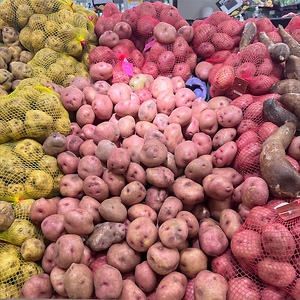


Canchán Potatoes
Estimated Inventory, lb : 0
Description/Taste
Canchán potatoes vary in size and shape, depending on growing conditions, but generally average 7 to 10 centimeters in diameter and have an oval, round, to flattened nature. The tubers are covered in shallow to medium-set eyes, sometimes giving them a lumpy, indented shape, and exhibit semi-rough, flaky, thin, and taut skin. The surface also showcases brown, light pink, and pink-red hues with some spots and markings, occasionally sold in markets with soil still enveloping the tuber, giving it a darker appearance. Underneath the skin, the cream-colored to yellow flesh is dense, hard, and slippery when raw, softening to a tender, smooth, creamy, and fine-grained consistency once cooked. Canchán potatoes have a mix of textures but are described as more waxy than floury. The variety is a multi-purpose tuber and can stay firm when select cooking methods are used. Canchán potatoes are edible after cooking and have a mild, earthy, and subtly buttery taste.
Seasons/Availability
Canchán potatoes are available year-round.
Current Facts
Canchán potatoes, botanically classified as Solanum tuberosum, are a Peruvian variety belonging to the Solanaceae or nightshade family. The tubers were developed and released in the late 20th century and have become one of Peru's most commercially grown potatoes. Canchán potatoes are prevalent in markets and are often seen stacked in large piles throughout local neighborhood markets, wholesalers, and supermarkets. The variety is also known as Papa Rosada, translating from Spanish to mean “pink potato,” a name derived from their rosy-hued skin coloring. Each Canchán potato plant has the ability to be high-yielding, producing 14 to 25 tubers per plant, and exhibits some disease and pest resistance. The variety was once famous for its resistance to late blight, a fungus that can destroy and devastate potato cultivation. This resistance propelled the tuber’s rise in cultivation, but recently, a new mutation of late blight has been found that Canchán is not well-suited against. Despite their decrease in resistance, Canchán potatoes are still grown throughout the coastal and mountainous regions of Peru and are marketed as an all-purpose table variety. Canchán potatoes are favored for their unique coloring, fairly large size, and ability to hold their shape when cooked, making them a popular variety for everyday culinary preparations.
Nutritional Value
Canchán potatoes have not been extensively studied for their nutritional properties. Some sources mention the variety may be a source of potassium, iron, calcium, and phosphorus, but the nutritional content often varies depending on the growing region. Potassium helps to balance fluid levels within the body, iron develops the protein hemoglobin for oxygen transport through the bloodstream, calcium protects bones and teeth, and phosphorus aids in repairing tissues. Potatoes, in general, are also thought to provide fiber to regulate the digestive tract, magnesium to control nerve functions, and other nutrients, including zinc, folate, manganese, and vitamin K.
Applications
Canchán potatoes have a mild, subtly sweet, neutral, nutty, and earthy taste suited for cooked preparations. The variety is marketed as an all-purpose table cultivar, meaning it can be used in everyday, home-cooked meals. Canchán potatoes are popularly roasted, boiled, and fried, and one of their most famous uses is for making crisp and fluffy French fries. The tubers are also boiled and tossed into salads, cooked and mashed, fried into chips, or added to soups, stews, and chowders. In the Andes mountains, Canchán potatoes are used in pachamanca, a traditional cooking method of heating the tubers in an underground oven with hot stones. The variety can also be used as a variation of locro, often paired with squash in the hearty strew, or mashed, stuffed with ingredients, and fried in papa rellena. Try Canchán potatoes in cau cau, an Afro-Peruvian creole stew comprised of chile peppers, herbs, aromatics, meats, and potatoes. Canchán potatoes pair well with herbs such as parsley, oregano, cilantro, and huacatay, mushrooms, corn, tomatoes, carrots, legumes, peas, yucca, sweet potatoes, and seafood such as fish, scallops, octopus, and prawns. Whole, unwashed Canchán potatoes will keep for several weeks to months when stored in a cool, dry, and dark location.
Ethnic/Cultural Info
Canchán potatoes were one of the first varieties released from a partnership between the National Institute of Agrarian Innovation, INIA, and the International Potato Center, CIP. INIA was established in 1978 and was renamed several times throughout the late 20th century to reflect the organization’s changing focus in the agricultural industry. INIA’s main goal was to promote research, breeding, protection, and evaluation of new and existing crops in Peru, and several experimental stations were constructed throughout the country to study potatoes. The International Potato Center was created in 1971 and is an organization focused on creating improved agricultural varieties for increased food security. In the present day, CIP has the largest gene bank of potatoes in the world, preserving over 7,000 samples. This diverse collection of genetics has allowed the organization to conduct several breeding programs to create new and improved commercial varieties. INIA and CIP partnered together to breed, evaluate, and release Canchán potatoes commercially, and it is said that over 10,000 clones were studied in the late 20th century before one was selected to develop Canchán potatoes.
Geography/History
Canchán potatoes are native to Peru and were developed by the International Potato Center, also known as CIP, in Lima, Peru, in the late 20th century. The variety was bred from a cross between Murillo III-80 and a variety known as (BI-1)2 in the 1970s. The tuber was a selection within the International Potato Center’s genetic improvement program and was bred to have improved resistance to late blight. Thousands of clones developed through the International Potato Center were evaluated and studied for many years, and the clones were sent to various partner programs and producers for advanced field testing. The National Institute of Agrarian Innovation, or INIA, evaluated many of these selections at an experimental station in Huánuco. One of the selections, initially known as INIA 303, exhibited the most desired traits in the trials and was named Canchán as a new commercial variety released in April 1990. Canchán potatoes quickly increased in popularity after their debut for their resistance to various pests and diseases. The variety also had high yields and a neutral flavor, making it a choice commercial cultivar. Today, Canchán potatoes are widely grown across Peru and thrive in varying climates from coastal regions to areas of the Andes. The potatoes are typically grown up to 3,500 meters in elevation and are one of the most planted commercial potato varieties. Canchán potatoes are notably grown in the regions of Ayachucho, Huánuco, and Junín and are shipped domestically to markets in Lima and across Peru. The variety is also exported and grown on smaller scales in Chile, Colombia, Ecuador, and Bolivia. The Canchán potatoes featured in the photograph above were sourced through markets in Miraflores and Surquillo in Lima, Peru.
Recipe Ideas
Recipes that include Canchán Potatoes. One



